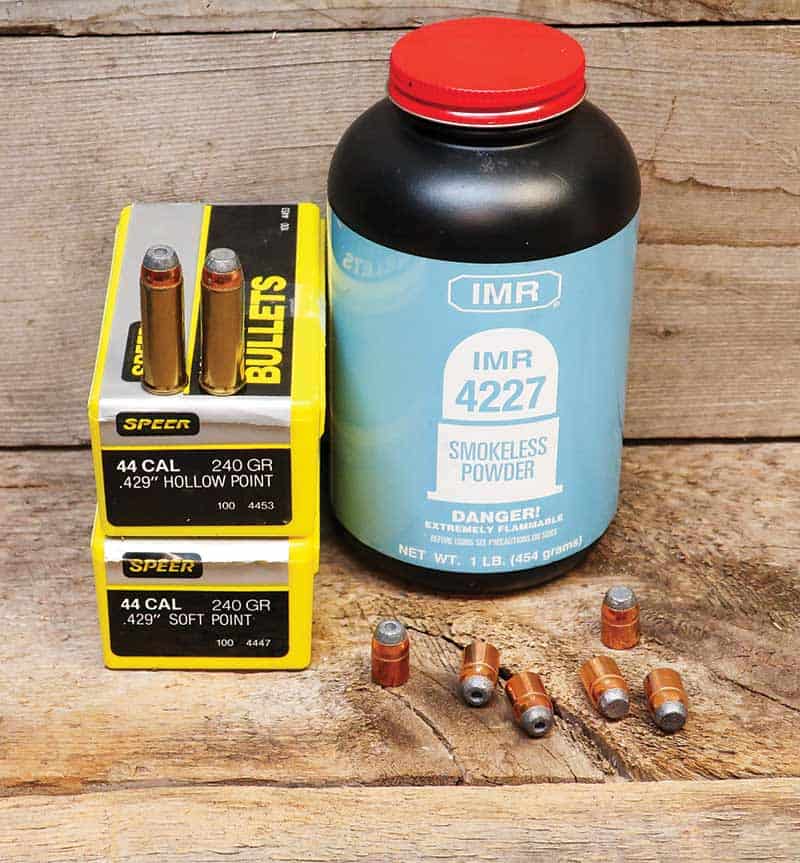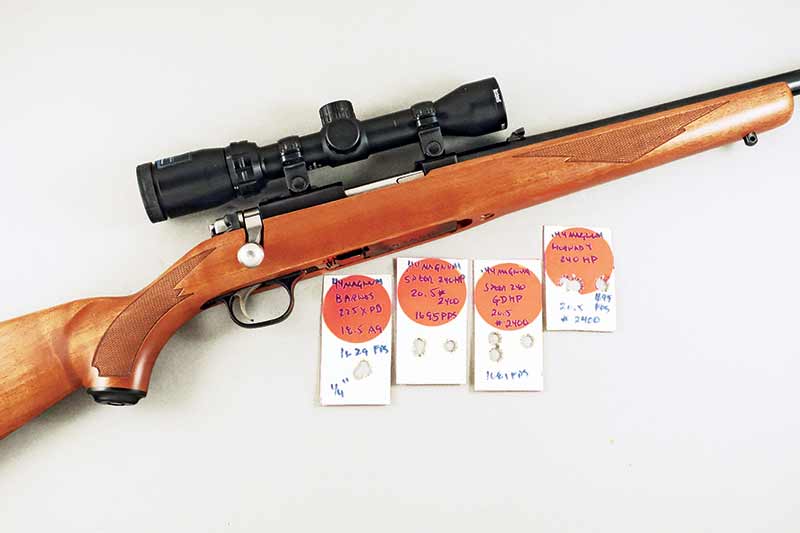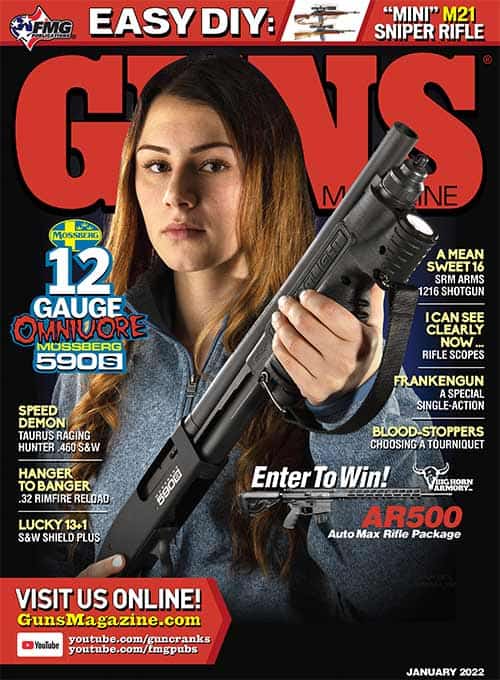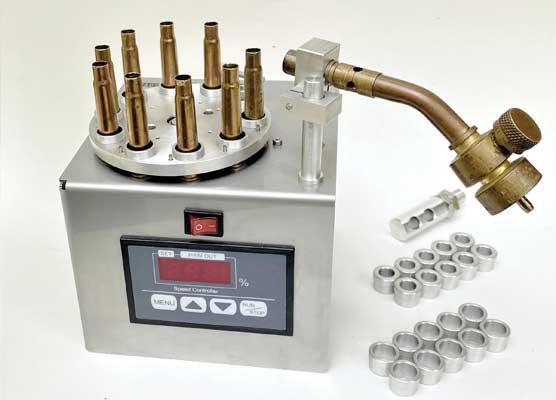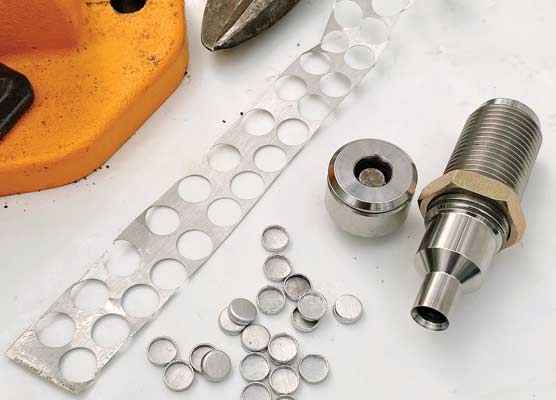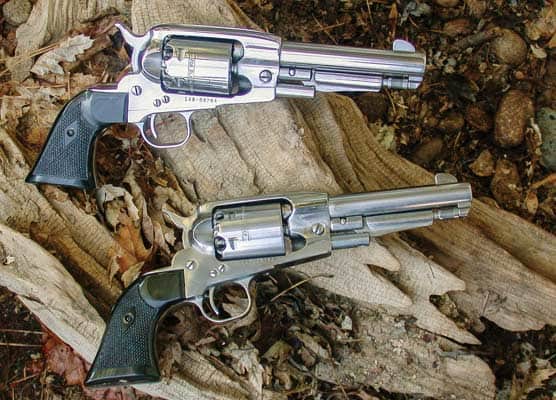Ruger .44 Magnum Carbines
Rifles even a sixgunner can love
Ruger has offered pistol-caliber carbines over the last 60 years chambered in .44 Magnum, including two semi-automatics, the Deerstalker and Deerfield, as well as a lever-action and bolt-action chambered for the .44 Magnum. Despite my love for sixguns, I am able to find room for these excellent rifles in my shooting heart.
Deerstalker and Deerfield
Ruger’s original Deerstalker arrived in 1961. Elmer Keith had high praise for it at the time saying: “True, it’s not a long-range weapon, but I cannot readily think of a handier and more deadly little gun for all timber and reasonable-range shooting of animals that are wanted for the table … It would also make a most excellent fighting weapon in close combat for any peace officer or the military.”
As so often happened with manufacturers, Ruger dropped the original .44 carbine because of the cost of production. In the newer Deerfield, this expense was addressed with simplified gas-operated feeding mechanisms. It does not have the classic look and very nice walnut stock of the Deerstalker, however instead of loading shotgun-style from the bottom as the Deerstalker it has a four-round removable magazine which is much easier on my fingers.
The Deerfield is quite selective as to which ammunition it will use, and overall length must be such that cartridges will enter the magazine, thus precluding the use of some of the Heavy-Duty hunting ammunition now available with long 300-grain bullets. One notable exception is .44 Magnum ammo loaded with 300-grain Hornady XTPs. Speer’s heavy-duty loading using the 270-grain Gold Dot also feeds flawlessly and the Deerfield easily handles the .44 Magnum loads with both 180- and 200-grain JHP bullets, however, Ruger cautions against the use of cast bullets because of the danger of lead buildup in the gas port.
Levers And Bolts
In addition to these two semi-automatic pistol caliber carbines, Ruger also offered both lever-action and bolt-action models. The Ruger 96/44 was Ruger’s .44 Magnum lever action using a rotary magazine holding four rounds, The 96/44 had a barrel length of 18-1/2″ with a weight slightly under 6 lbs. The Model 96/44 comes easily to the shoulder and points naturally for this shooter. It would be a top choice for hunting in deep timber for anything of the deer/ black bear/hog sized category.
Ruger’s latest rifle entry chambered in the .44 Magnum is the Model 77/44. The gun turned out to be one dandy little carbine which dispelled any misgivings I may have had about such a chambering in a bolt action rifle. With the same 18-1/2″ barrel length as found on the old Deerstalker, if anything the 77/44 feels even more compact and handles even easier. Conventional leverguns are often difficult to load through their loading gates on the side of the receiver especially in cold weather. The 77/44 reloads quickly with the removal of an empty magazine by pressing in on the lever behind the bottom of the magazine and replaced by a full magazine carried easily in a jacket pocket.
If the Ruger Model 77/44 has one drawback it’s the same as for the semi-automatic .44 Deerfields — namely the fact the magazine will not accept rounds with long-nosed bullets, meaning such excellent hunting rounds such as Garrett’s 310-grain hard cast Keith bullet .44 Magnum load cannot be used except as a single shot. The same is true for the old standard Keith loading of the 260-grain hard cast semi-wadcutter bullet over 22.0 grains of #2400.
For the handloader this means overall cartridge length is very important. I find it helpful to make dummy rounds with properly seated bullets without primer or powder to make sure they will feed flawlessly and chamber correctly. I often caution reloaders who our seeking loads for both their sixgun and rifle to find their rifle load first as they are more picky about cartridges than sixguns are. This is especially true with the Ruger rifles.
Since cast bullets can cause problems in the semi-automatic Ruger carbines, I normally stick with jacketed bullets for all of my loads for the Rugers. Powders include IMR4227, Alliant #2400, Accurate #9 and Hodgdon’s H110. My most-used jacketed .44 Magnum bullets are Hornady’s 240 JHP and 265 FP, and Speer’s 240 JHP, GDHP and JSP. All of these, when crimped in the crimping groove, will feed and chamber through all Ruger .44 Magnum carbines. I especially appreciate the quality of Redding’s Titanium Carbide .44 Magnum dies and use them for all reloading for Ruger rifles.
Accuracy
With previous shooting of factory loads, I found all three of these rifles will stay well under 2″ for three shots at 100 yards. For this round of testing, I went with nine handloads with seven of those being standard 240-grain bullets and the other two a 225 Barnes XPB and the Hornady 265 FP originally designed for the .444 Marlin. The 77/44 averaged exactly 1″ for three shots with all loads, the Deerstalker came in just over 1″, while the Deerfield was the most accurate at just under 1″. So actually there is no practical difference in accuracy between the three.Ruger has offered pistol-caliber carbines over the last 60 years chambered in .44 Magnum, including two semi-automatics, the Deerstalker and Deerfield, as well as a lever-action and bolt-action chambered for the .44 Magnum.
For the 77/44 the two most accurate loads were the Speer 240 HP over 20.5 grains of #2400 for just over 1,700 fps while the Barnes 225 XPB with 18.5 grains of Accurate #9 clocked out at 1,625 fps and shot all three bullets into the same hole measuring 1/4″ center to center. Two other Full House loads which performed exceptionally well were loaded over 20.5 grains of #2400 and both shooting in 1″ were the Speer 240 GDHP and the Hornady 240 HP with both clocking out right at 1,700 fps.
Switching to the Deerstalker, the most accurate loads all just under 1″ were the Speer 240 SP over 22.5 grains of #4227 for an easy shooting 1,425 fps; the Speer 240 SP with 20.5 range of #2400 for 1,650 fps; the Speer GDHP also with 20.5 range of #2400 for 1,630 fps; and the Hornady 265 FP just under 1,600 fps with 21.5 grains of H110. My favorite of the three, the Deerfield, shot the following loads at less than 1″: the Speer 240 SP with 22.5 grains of #4227 and 1,485 fps; Speer 240 HP, 20.5 #2400, 1,680 fps; Hornady 240 SIL, 21.0 Accurate #9, 1,675 fps; and the 225 Barnes XPB which clocks out at 1,634 fps using 18.5 grains of Accurate #9.


